Notes: Mablethorpe was the principal station on the loop line and opened as the terminus of the Louth & East Coast Railway on 16th October 1877, becoming a through station when the Willoughby & Sutton Railway extended their line to Mablethorpe on 14th July 1888. The station had two through platform faces and two bay platforms facing north towards Louth. In later years these platforms weren't generally used for passenger trains as most of the holiday excursions came from via Willoughby to the south.
The station was improved by the GNR in 1889 including alterations to the down waiting shelter and new rooms in the main buildings; it is likely that the footbridge was erected at this time.
 |
There was a substantial goods yard to the north west of the station with access controlled by a signalbox on the up side of the line to the north of the station. A 60-foot long single road timber engine shed was opened with the station but this was closed in June 1924. A windmill was erected there to pump water which is believed to be unique in the UK. To the north of the engine shed |
there was a 45-foot turntable, this was replaced by a larger turntable in the 1950s.
The station also had a weigh office and weighbridge, a brick goods shed, cattle pens and loading dock, 1.5 ton crane and three carriage sidings for stabling excursion trains. On some summer Sundays these weren't sufficient with the goods shed road also being used. Sometimes there were so many excursions arriving at Mablethorpe that up to six trains had to be backed onto the Louth line which had no Sunday service. On one occasion in the 1930s the Fire Brigade had to be called in to pump water for the engines from the dyke as the town's supply had run dry.
During the 1953 flood Mablethorpe had to be evacuated with much of the town under five to six feet of water. The railway was on higher ground and clear of the water and was used extensively to bring emergency supplies into the town and for a time the station was used as a temporary police station.
| The line into Mablethorpe was listed for closure under the Beeching plan and the goods service was then withdrawn from 30th March 1964. There was however a bitter and protracted campaign to keep the station open to passenger traffic which was spearheaded by the Mablethorpe and Sutton Urban District Council. During this period the railway service was run down by BR despite earlier assurances that they would "develop holiday traffic". |
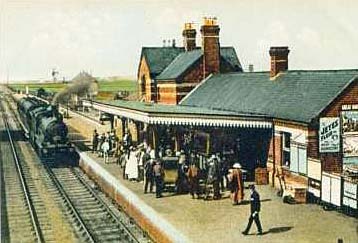 |
After lengthy hearings the Transport Users' Consultative Committee advised against closure but the final decision lay with Minister of Transport who sided with BR and closure was announced for 5th October 1970 with the last train leaving Mablethorpe on Saturday 3rd October. The 2 car DMU with 125 seats had nearly 500 people and two coffins on board.
BRIEF HISTORY OF THE MABLETHORPE LOOP LINE
A line to Mablethorpe was first proposed in 1864 running from the East Lincolnshire Railway at Alford via Beesby to Mablethorpe. An Act for the new line was obtained on the 29th July, 1864, but lack of local finance meant work couldn't start and powers eventually lapsed.
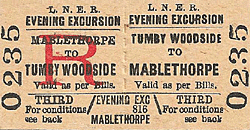 |
In 1871, the Louth and East Coast Railway was formed to build a line from Louth to Mablethorpe with a branch from Saltfleetby to North Somercotes. The company received its Act on 18th July 1872 and the Great Northern Railway agreed to work the line for 50% of the receipts, providing staff and 4 trains a day for twenty one years. |
In October 1873 a proposal to build the original route between Mablethorpe and Alford was resurrected but despite local support, a Bill was rejected by Parliament because Mablethorpe would be adequately served by the L & ECR where construction would soon be underway.
Contractor Henry Jackson was appointed to build the line and work started in September 1875 with the optimistic intention of opening in the summer of 1876. Progress was however slow and by July 1876 rails were only laid as far as Grimoldby, the first station out of Louth which was also still under construction at this time. A second Act was obtained on 17th May, 1877 to allow for a deviation in the route and additional time to complete the single track line.
| The Louth & East Coast Railway opened on 16th October 1877 with intermediate stations at Grimoldby, Saltfleetby and Theddlethorpe. As well as holiday traffic to Mablethorpe, the line passed through rich grazing land which would also bring additional income to the line with livestock being carried from all stations to Louth Cattle Market. |
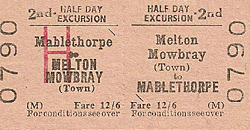 |
Under the 1884 Harbour & Dock Act, the Sutton and Willoughby Railway Company was formed to build a line from the new Sutton Docks to Willoughby on the East Lincolnshire line in order to distribute locally caught fish to markets around the country. Shortly before the Bill went before parliament a 2ft 6in. gauge steam operated tramway opened between Alford and Sutton on 5th April 1884. This tramway was initially very popular but public support turned towards the proposed railway and the Sutton & Willoughby had little trouble getting their Bill through Parliament on 28th July 1884 despite opposition from the tramway.
Contractor James Dickson started work at Willoughby in June 1885 and with a flat route and few bridges progress was rapid with the 7 mile 13 chain line being completed in little more than a year. The GNR refused to work the line until the Sutton Dicks were built but the Sutton & Willoughby argued that they couldn't build the docks without the railway. The GNR eventually agreed to work the line for 21 years in return for 50% of the receipts. The line was formally opened on 23rd September 1886 with general traffic starting on 4th October with five daily trains. One intermediate station was provided at Mumby Road, another proposed station at Huttoft was never built.
On the 25th September an Act authorised the Sutton and Willoughby Railway to extend their line to join the L & ECR at Mablethorpe; despite objections from the tramway the Bill was passed. The 2 mile 47 chain extension took three months to complete, opening on the 14th July 1888. The opening of the loop line meant the end of the line for the tramway which closed in 1889 following a dramatic fall in passenger revenue.
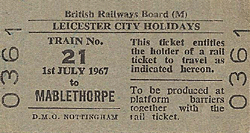 |
Since the opening of the Sutton line work on the docks had not started. In 1891 the Lancashire, Derbyshire and East Coast Railway received parliamentary consent to build a cross country line from Warrington, on the Manchester Ship Canal via the Derbyshire coalfields to Sutton-on-Sea. Construction was rapid and by 1897 the new line had reached Lincoln but then |
the money ran out ant it got no further. The LD & ECR had planned to take over both the L & ECR and the S & WR but the scheme was scrapped when the Sutton & Willoughby was unable to repay its debts to the Great Northern. Both lines eventually became part of the GNR, the S & WR in 1902 and the L & ECR in 1908.
In its early years, the Louth and East Coast line had been doing well and the extension of the Sutton line into Mablethorpe was an immediate success bringing large numbers of visitors to the resorts of Mablethorpe and Sutton-on-Sea which quickly expanded. World War I brought an influx of long troop trains bringing hundreds of young soldiers to the numerous training camps in the area. After the war the number of passengers arriving at Mablethorpe increased to a peak of 166,000 in 1936.
| Local passenger traffic included children travelling to Louth schools from Mablethorpe, Theddlethorpe, Saltfleetby, Grimoldby, Sutton and the surrounding villages. Passenger numbers at Mablethorpe were still a respectable 124,000 in 1952 rising to 136,400 in 1959 but the tide was about to turn with the increasing popularity of road transport. By 1959 line between Mablethorpe and Louth which was losing £9,500 a year, passenger and freight traffic was in decline and urgent repairs were required to Mablethorpe |
old27.jpg) Rare view of the timber engine shed (behind the goods shed)
Rare view of the timber engine shed (behind the goods shed)
Photo from Roger Griffiths collection |
Junction at Louth.
In October 1960 British Railways announced its intention to close the line. As most of the holiday traffic to Mablethorpe and Sutton came via Willoughby closure of the Louth line would have little affect on this. The British Transport Commission stated that the Willoughby - Mablethorpe line would remain open with services developed if demand increased. The closure of the Louth line would allow improved stabling facilities to be provided at Mablethorpe which would make possible an increased number of excursion trains via Willoughby.
With little opposition the line closed from 5th December 1960 with the last train running two days earlier. The track was lifted in February 1963.
 |
Despite assurances that the Willoughby - Mablethorpe line would remain open there were local concerns especially from the Mablethorpe & Sutton Urban District Council that within a few years that line two would be earmarked for closure. With the publication of the Beeching report the Council’s concerns were turned into reality in just four years. |
There had been no attempt to carry out the earlier plans “to develop holiday traffic to Mablethorpe and Sutton.” Instead there had been a deliberate “run down” of railway services with a reduction of cheap tickets and the withdrawal of services from time-tables. By the time the public hearing took place BR were able to claim fewer passengers were likely to suffer hardship because people had been deterred from using the services by the reductions.
The Beeching Plan proposed the closure of virtually the whole of East Lincolnshire to railway traffic. Peterborough – Grimsby via Boston, Lincoln – Firsby via Bardney, Willoughby - Mablethorpe and the Skegness branch. The goods service over the Mablethorpe line was withdrawn from 30th March 1964 and opposition to the proposals to withdraw the passenger services was fierce and prolonged; a public inquiry was held in Skegness on 15th and 16th September 1964.
| The Mablethorpe and Sutton case being made by the Mablethorpe and Sutton Urban District Council. One of the main reasons put forward by the Council for not closing the lines was poor or inadequate roads to the town from the proposed railhead at Boston. The findings of the meeting were submitted to the Minister of Transport who concluded that the British Railways |
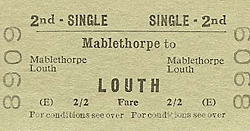 |
board should re-examine its proposals. This it did and in due course once again proposed closure, this time with the exception of the Skegness line. A second TUCC inquiry was held at Skegness in May 1968 and its decisions were again submitted to the Transport Minister who this time supported the Board’s proposals.
The Minister was satisfied that there could be no justification for retaining services between Firsby and Grimsby, he also decided that he should give his consent to the withdrawal of passenger services on the Willoughby - Mablethorpe branch line stating that although closure would effect the holiday industry during its short season there were insufficient regular users of the service during the rest of the year to justify retaining the service. Only the Skegness line would remain open.
Closure was announced for 5th October 1970 with the last train running two days earlier. The track between Mablethorpe and Willoughby was lifted in 1971. Because of the flat nature of the landscape little of the line remains today apart from the three substantial station buildings between Mablethorpe and Louth.
Tickets from Michael Stewart, Dave Barton & Brian Halford. route map drawn by Alan Young
Source: The Louth, Mablethorpe & Willoughby Loop by AJ Ludlam. Published 1987 by Oakwood Press ISBN 0 85361 354 0
Other web sites:Dave's Railpics of Lincolnshire. David Enefer's excellent web site crammed with pictures of Lincolnshire stations,
To see other stations on the Mablethorpe loop line click on the station name:
Louth, Grimoldby, Saltfleetby, Theddlethorpe, Sutton-on-Sea, Mumby Road & Willoughby |

old3.jpg)


old11.jpg)
old16.jpg)
old20.jpg)
4.jpg)
3.jpg)






old27.jpg)
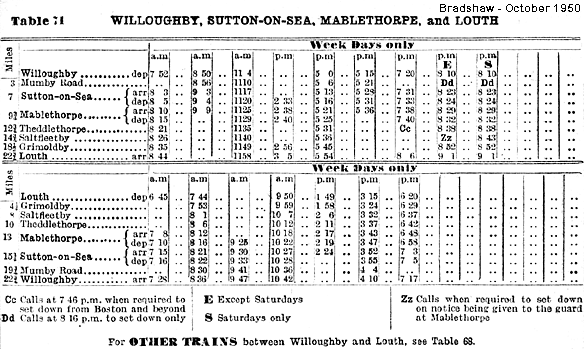


4.jpg)

 Home Page
Home Page